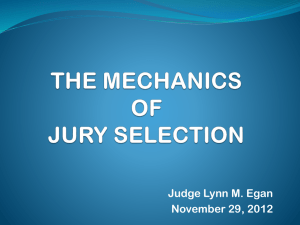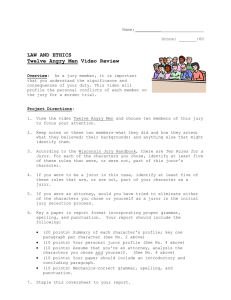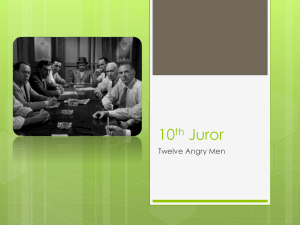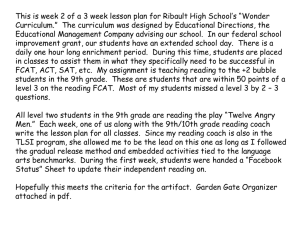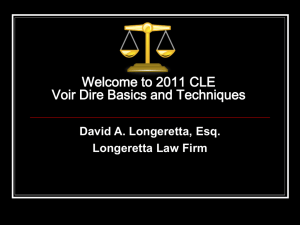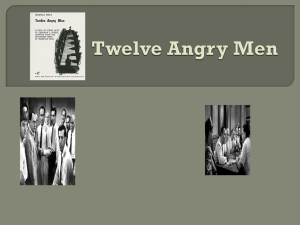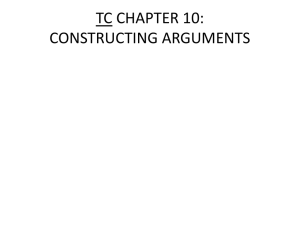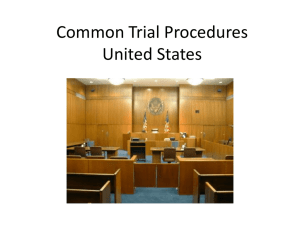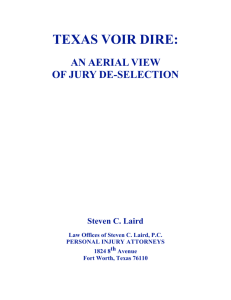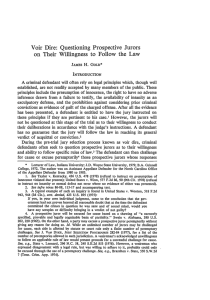Voir Dire
advertisement
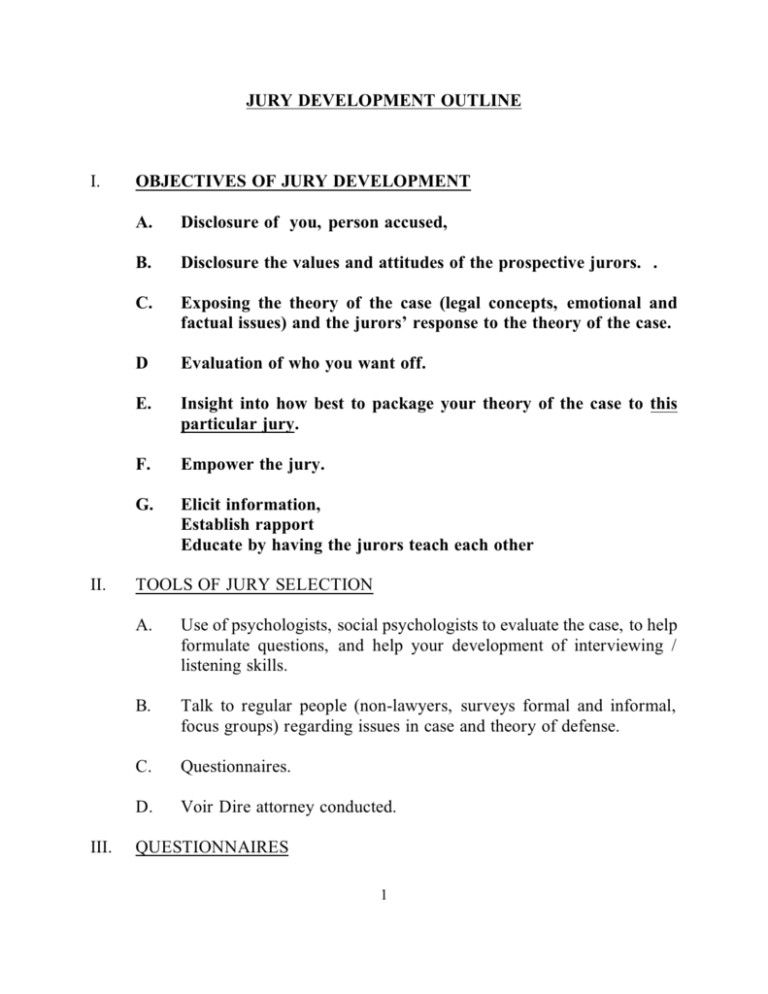
JURY DEVELOPMENT OUTLINE I. II. III. OBJECTIVES OF JURY DEVELOPMENT A. Disclosure of you, person accused, B. Disclosure the values and attitudes of the prospective jurors. . C. Exposing the theory of the case (legal concepts, emotional and factual issues) and the jurors’ response to the theory of the case. D Evaluation of who you want off. E. Insight into how best to package your theory of the case to this particular jury. F. Empower the jury. G. Elicit information, Establish rapport Educate by having the jurors teach each other TOOLS OF JURY SELECTION A. Use of psychologists, social psychologists to evaluate the case, to help formulate questions, and help your development of interviewing / listening skills. B. Talk to regular people (non-lawyers, surveys formal and informal, focus groups) regarding issues in case and theory of defense. C. Questionnaires. D. Voir Dire attorney conducted. QUESTIONNAIRES 1 IV. A. Include cause areas, publicity, private areas (sexual assault, abuse, drug and alcohol problems, etc.). B. Saves court time while getting more truthful answers. C. Can provide record for cause challenges and motions in limine. VOIR DIRE - A WORKING DEFINITION Voir Dire is a guided group interview and discussion of the legal, factual and emotional issues involved in your case. Powers v. Ohio (1999) 499 US 400, 111 S.Ct. 1364, the United States Supreme Court held, “... the voir dire phase of the trial is the jurors first introduction to the substantive factual and legal issues in the case” (Id. at page 1371) V. WHAT SHOULD THE VOIR DIRE PROCESS ACHIEVE? The exposure and discovery of you, the person accused, and the prospective jurors. Values and attitudes. The learning of the theory of the case (includes relevant legal concepts by the prospective jurors) and jurors response to the theory of the case. The acquiring of sufficient information, verbal and non-verbal to establish the record for cause challenges and the intelligently exercise the peremptory challenges. To acquire insight into how to best package your theory of the case to this particular jury. To empower the jury (give away control) / Instill fear of convicting an innocent person. 1. How to guide the Voir Dire interview and discussion: 2 a. All segments of trial practice contain three aspects: Technical - nuts and bolts, open-ended questions, sequencing, etc.. Substantive - the subject matter (ex.:values, drugs, race, guns, etc..) Emotional - what emotions or feelings that you have or the jury will have about the subject matter. How will they best understand and accept our message. All three must work in harmony if there is to be effective and persuasive presentation. b. Pre Voir Dire Preparation: Must prepare yourself emotionally. What were your problems factually, legally and emotionally with the case? Become a good listener. Explain to your client this his or her non-verbal behavior will be observed by the jury and will be extremely important. Help the client to be a pair of eyes and ears to report what he sees going on during voir dire. Pre-test your voir dire and theory of the case on non-lawyers. Remember, you are of the facilitator of a guided group interview and discussion. You are more like an engaging talkshow host than a lawyer ( Phil Donahue, Oprah Winfrey) c. Interview Techniques: 3 Self-disclosure - you tell something first about yourself, about the person accused. Concreteness - tell them why you are asking the question. Reflection - Repeat back to them what you heard them say. See who shares or differs with that answer, belief or common feeling. Reward their honesty. (No bad answers). Encourage everyone to be honest and open. Ask a single juror no more than three questions at one time Get it and spread it Establish Eye Contact - use non-verbal actions by jurors; smile laugh, frown, etc. as an introduction to ask them a direct question. Try to get the jurors sharing and interacting with one another. (The more they talk, the more you learn; the more they interact with one another, the more you learn of how they would interact in the jury room and the less likely the judge is to cut off your voir dire because the citizens are talking and not you.) Ask open-ended questions! - Most important!! There are no bad answers in jury selection (the opposite of cross-examination). Examples: *what was the first thing that came to your mind when...? *what do you feel when you hear.....? *what was your gut reaction..... why?..... *have you ever heard others say.....? *have you ever heard of instances when...? *could you share some examples? *what do you think about what you heard? *does anyone else have examples or experiences? 4 *what would you suggest? *how would you ask a question regarding racial feelings; on drugs, etc.? *I am concerned that...(race, homosexuality, drugs, guns, etc.) may affect how someone would view the evidence in this case. *why do you think I may feel that way? Do you think this is a legitimate fear? *how many people are reluctant to talk in of strangers front about themselves? Ask headline questions Example:. Some people may think the fact that someone owns a gun means that they are a violent person other may think that gun ownership has nothing to do with whether someone is a violent person what do you think? Ask spectrum questions Example: With 1 being not strong at all and 5 being very strong. This How would you agree your feelings about...? Get it spread it Remove Barriers - between you and the jury. Do not stand behind the podium and chairs. Have someone else watching the jurors while you are doing your voir dire. Empower the jury - ask their permission to inquire into certain areas. Stress their importance and their significance as individuals and collectively. Organization of voir dire Introduction 5 Strong topic Areas of concern /what you fear the most Strongest topic conclusion Robert Hirschhorn’s top 10 questions phrases attorney should never use in voir dire 10. Do you understand the law says...? 9. I take it from your silence that no one disagrees with the proposition that...? 8. Does anyone have a problem with...? 7. Will you keep an open mind and not decide this case until you have heard all of the evidence? 6. Can you set aside your biased and decide the case on the facts? 5. Has anyone formed an opinion about...? 4. To every one of you be fair and impartial juror in a case like this? 3. Will you promise me that...? 2. I trust you will agree...? 1. Do any members of the panel have any feelings about...? The better way to ask a question it is to directed it to a particular juror. For example: (juror’s name)what feelings do you have about...? Unless you are required by the court asked the question of the entire panel. Ask the question to a particular juror 6 Introduction Introduce yourself and the person accused. (You may also want to introduce court staff or personnel which were not introduced by the judge). Hello I am proud to be here with (client’s name have client stand up and nob or say hello) and to have 12 of you decide this very important case. In this part of the trial we need to find out your feelings, impressions or opinions about the issues in this case. I want you to know that there are no right or wrong answers only honest answers. We must rely, and can only rely, upon their honesty and integrity in examining their conscience and answering our questions as fully and completely as possible. If there is any answer which you do not want to discuss in public please asked the judge and we can discuss it in private. If my question is not clear to you please let me know and I will clarify what I mean. If you do not understand why I am asking the question please let me know and I will tell you. I also want each one of you to feel free to at any time to volunteer any comments or questions they may have regarding any topic that we are discussing. Inoculation against “rehabilitation” Why do you think you were asked if they knew any of the people involved in 7 this case? What does bias means to you? Are bias always bad? Or are they just part of our human nature and the life experiences that we carry with us. How many people have heard that there is a duty to serve on a jury? What does that mean to you? How many think they may be a duty not to serve on a particular jury an particular case? Why? Example: I should not sit on a DUI case because twice I was struck by a drunk driver and even though I would like to think I could be fair and impartial, I probably would not, and there are other cases where I could do a better job. Is there anyone on the jury that can think of a situation where they should not sit on the particular jury? When have you been told to change a deeply held belief? Explain situation. How did you feel when you were told to change your deeply held belief? Do you think is fair to be told that you should put aside a deeply held belief? There are some beliefs which you hold which you would not change just because someone may ask or want you to change? Do you think it would be hard to put aside a deeply held belief? Why? How many people think they would be a better juror on a case where you were not asked if you could put aside a deeply held belief? e. Things to Remember: Voir Dire is jurors’ first impression of you, the person accused and the case. 8 Be Be Be Be Be Be yourself honest helpful diligent knowledgeable of your case knowledgeable of the law Be conversational Do not engage the jurors in an argument or try to change their mind. Everyone is free to have their own ideas and not to have someone try to change them. Remember, voir dire is an interview and discussion, you are trying to find out about them and educate them about your theory of the case. Listen and hear what the juror is saying and ask what they mean. Don’t assume you know. C. Exposing the theory of the case and relevant legal concepts by the prospective jurors. Theory of the case: That combination of facts beyond change and law which in a common sense and emotional way leads the jury to conclude that the person accused has been wrongfully charged. 1. Life experience voir dire Asks for examples in their past how they have dealt with the particular situation or issue in this case. Use examples from ordinary life (school, occupations, hobbies) to illustrate legal concepts, factual elements and emotion of your case. Examples: Computer Person - is aware that garbage in, garbage out. He/she is 9 also aware that insufficient data would not allow a program to run and that insufficient data will give inaccurate results. This ties into the burden of proof, lack evidence, etc. School teachers - or anyone who has been though school knows of the student who always waived their hand to answer first, sure that they had the right answer. Often times, however, the student was wrong. Certainly does not mean accuracy (ID Cases). Medical Profession - aware of a “false-positive”. A test which showed positive results but was actually inaccurate discovered only upon a second test of further investigation. 2. Legal Concepts: General A burden of proof Presumption of innocence Right to remain silent Beyond the exclusion of every reasonable doubt Specific Self-defense Insanity Consent Etc., ... 3, The bad stuff in the case: Drugs Guns Race The confession Tape recorded conversation Videos Nature of the Crime (murder, rape, etc.) 10 4. Voir Dire on Insanity, Anger, Intoxication, Drug Usage (Affirmative Defenses) Have the jury discuss these issues in terms of how these matters would affect a prospective juror’s ability to knowingly, intentionally and intelligently listen to the evidence and make a rational decision. C. Evaluation of who you want off the jury: 1. Challenges for cause. When you get a potential “cause challenge” answer, “bad” or “great” answer from a juror you should do the following: GET IT AND SPREAD IT How many believe...? List everyone who raises their hand How many believe (the opposite)....? List everyone who raises their hand How many at this point have no opinion one way or another? List everyone who raises their hand Reinforce the juror’s candor and openness Lock them into the position. Example: I am sure this is a belief that you have had for a while and that you hold rather strongly. Immediately ask others who agree with this answer and reinforce their candor and openness and likewise lock them into their position. You may want to tell them that you would imagine that they are not the wishywashy sort of people would change their views on something just to please someone. Even though they do not want to show disrespect to the court, they still have these feelings no matter what the law or the judge says they should feel. You can also ask the juror if they would feel more comfortable or whether they feel they could do a better job on a case where this particular “cause issue” 11 would not arise. If they would rather serve on that jury, you should then ask if they would have any objection to you asking the judge on their behalf to sit on another jury. Articulate for the records an relevant non-verbal behavior of the juror, judge or prosecutor. Next, Turn to the people who disagree. Why do they disagree? Next, Ask for people who originally were not sure have they taken a side or are they still unsure. Asked why? Make sure that you keep an accurate record of what individuals fall into what group. Making a record of their responses and preserve the issue. Make sure the record is clear as to their answers. Use all of your peremptory challenges. Ask for more peremptory challenges You must exhaust all of your peremptory challenges in order to properly preserve the issue. Further, place on the record the names of all jurors who are presently on the jury that you would have struck had you not been forced to use a peremptory challenge on someone who should have been struck for course or if you had been given extra peremptory challenges. 2. Peremptory Challenges: They are what they say - Richard Kammam Why do you want the person off? It is very important to have extra eyes and ears present during your voir dire to help you make this decision. Consult your client. Be aware of the social leaders, people who seem to dominate the conversation. Talk with everyone! Make sure that people who are on your jury are not the ones who you know the least about. 12 Never infer anything from a juror’s silence! Do not stereotype. Look for case specific jurors. Be careful not to pick people with whom you would like to share dinner or a beer. Often times, they may be great for dinner or a beer, but may not agree with your theory of the case. Know what you are looking for; a lesser, a not guilty or a hung jury. Batson challenges Creating the record (List Batson requirements) Preserving the Record Checklist for Jury Selection 1. Make a clear record of juror’s name/number and answer/comment made by the juror 2. Put nonverbal reactions of juror on the record. 3. Challenge the juror for cause. 4. Use all of your peremptory challenges. 5. Ask for more peremptory challenges. 6. You must exhaust all of your peremptory challenges in order to properly preserve denial of cause challenge issue. United States v. Schlei, 122 F.3d 944, 955 (11th Cir. 1997). 7. Object to the jury composition and place on the record the names of all jurors who are presently on the jury that you would have struck had you not been forced to use a peremptory challenge on someone who should 13 have been struck for cause or if you had been given extra peremptory challenges. 8. Batson challenges. A. Defendant must first show a prima facie case of discriminatory intent. Kentucky v. Batson , 476 U.S. 79, 93-94. Defendant does not have to be of same race as juror Powers v. Ohio, 499 U.S. 400 (1991). Gender discrimination is also cognizable. J.E. B. V. Alabama, 511 U.S. 127 (1994). B. The burden then shifts to the government to rebut the inference by articulating legitimate, race-neutral reason for its exercise of its peremptory challenge. Vague explanations are insufficient to refute a prima facie case of racial discrimination. United States v. Horsley, 864 F.2d 15143, 1546 (11th Cir. 1989). C. If the government has cleared the second hurdle, the trial court has the responsibility to determine whether the defendant has established purposeful discrimination. Purkett v. Elem, 514 U.S. 765, 767-68 (1995). Best evidence is the attorney’s demeanor, as well as the demeanor of the juror. Hernandez v. New York, 500 U.S. 352, 365 (1991). D. Acquire insight into how best to package your theory of the case to this particular jury 14 1. Keep in mind the occupations, life experiences and answers given by the jurors on your panel so you can tailor your word choices, analogies and certain parts of your closing arguments directly to them by establishing eye contact with the individual juror when you are making that point. 2. Note that your theory of the case would not change based on who is on your jury, but, how you present that theory of the case should be adjusted and colored in such a way so it may be more readily understood by the particular individuals you have on your jury. 15


